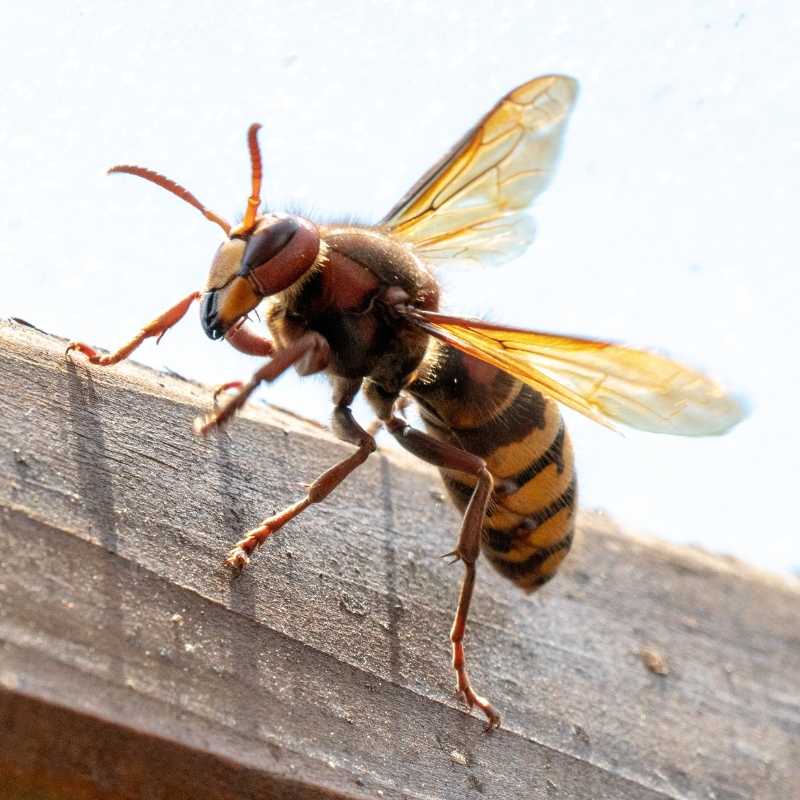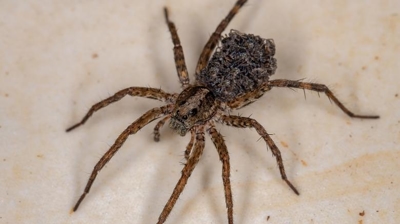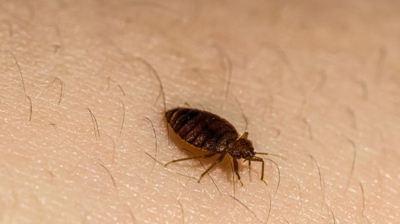
Hornets

Are Hornets Harmful?
Hornets are social wasps that can be considered harmful in several ways:
- Physical Harm to Humans and Animals: Hornets are capable of delivering painful stings. Their stings inject venom that can cause intense pain, swelling, redness, and itching. For some individuals, especially those with allergies to insect venom, stings can trigger severe reactions such as anaphylaxis, which can be life-threatening. Multiple stings, even in non-allergic individuals, can lead to systemic effects like nausea, fever, and in rare cases, organ damage.
- Aggressive Behavior: Some hornet species, like the Asian giant hornet, are highly defensive and aggressive when their nest is threatened. This makes accidental human encounters near nests more dangerous. Hornets can pursue perceived threats over long distances, increasing the risk of stings.
- Psychological Stress: The presence of hornets, particularly large or aggressive species, can create fear and anxiety for homeowners, gardeners, or workers in affected areas. This can limit outdoor activities or interfere with daily life, particularly for children or individuals with previous sting experiences.
- Damage to Property: Hornets often build nests in sheltered areas, such as attics, wall voids, garages, or trees. Large nests can cause structural damage, obstruct ventilation, or even weaken certain building materials over time. Removing nests can also be costly and often requires our professional intervention to ensure safety.
- Threat to Pollinators and Ecosystems: Some hornet species prey on bees, especially honeybees. They can decimate local bee colonies, which are crucial pollinators for agriculture and wild plants. Loss of bees reduces crop yields and negatively affects biodiversity.
- Economic Impact: By preying on honeybees, hornets indirectly threaten agricultural economies that rely on pollination. Beekeepers may suffer financial losses due to reduced honey production or the need to protect hives with costly barriers or relocations.
Hornets pose a combination of direct physical threats, indirect ecological and economic damage, and psychological stress, which makes them a significant pest in both urban and rural contexts.
Learn more: What Do Hornets Look Like? || What Do Hornets Eat?
Hornet Removal
Getting rid of hornets is important for several reasons:
- Health Risks: Hornets pose significant health dangers due to their potent venom. Hornet stings are more painful than typical wasp stings and can cause severe pain, swelling, and tissue damage. Individuals allergic to hornet venom are at risk of life-threatening anaphylaxis, requiring immediate medical attention. Even non-allergic stings can lead to secondary infections if the skin is broken and not properly treated.
- Aggressive Behavior: Hornets are highly territorial and aggressive, especially when their nests are threatened. Unlike bees, which usually sting only in defense, hornets can attack in groups and pursue perceived threats over long distances. This aggressive nature makes them particularly dangerous around homes, gardens, playgrounds, and outdoor work areas.
- Threat to Pets and Livestock: Pets, livestock, and wildlife may be stung by hornets. Dogs and cats are especially vulnerable to severe reactions if stung near sensitive areas such as the face, throat, or paws. In rural or agricultural settings, hornets can repeatedly harass livestock, causing stress, injury, or in severe cases, death.
- Property Damage: Hornets build large, paper-like nests in trees, shrubs, attics, wall voids, and eaves. Over time, these nests can damage structural elements, insulation, or siding. Prompt removal prevents nests from growing large enough to cause significant property damage or increase the risk of human exposure.
- Impact on Outdoor Activities: Hornet infestations make outdoor spaces unsafe and often unusable. Gardens, patios, decks, playgrounds, and other recreational areas can be compromised. In public or commercial spaces, hornets near entrances or common areas create liability risks for property owners.
- Ecological Considerations: Although hornets help control other insect populations, uncontrolled infestations near human dwellings are hazardous. Our professional removal allows for maintaining ecological balance while minimizing risk to humans, pets, and property.
- Professional Removal Is Recommended: Due to hornets’ aggression and the often hard-to-reach locations of their nests, DIY removal is extremely dangerous. Our licensed pest control professionals can safely eliminate nests, reduce the risk of stings and allergic reactions, and implement measures to prevent future infestations.
Hornets are not just a nuisance—they are a serious health and safety hazard, and early intervention reduces the risk of stings, allergic reactions, property damage, and disruption to daily life.
Learn more: How To Get Rid Of Hornets
Hornet Control
Hornets are among the most aggressive and dangerous stinging insects, and attempting to eliminate them on your own can quickly put you, your family, and your property at risk. Choosing our professional hornet control ensures safety, effectiveness, and long-term prevention. Here are some of the reasons why our professional services are the best option:
- Safety First: Hornets are highly territorial and will swarm aggressively when their nest is disturbed. A single colony can send out dozens of stingers within seconds, and unlike bees, hornets can sting multiple times. Our professional technicians use specialized protective gear, equipment, and removal methods that eliminate the threat without exposing you to dangerous encounters.
- Expert Identification and Strategy: Not all stinging insects are the same. What looks like a hornet’s nest may actually belong to yellowjackets, paper wasps, or bald-faced hornets, each requiring a different approach. Our professionals accurately identify the species and implement the most effective treatment to target the specific pest.
- Complete Nest Elimination: DIY sprays often only kill hornets on the surface, leaving the queen and deeper parts of the colony untouched. Our professionals ensure that the nest, larvae, and queen are fully destroyed, preventing the colony from rebounding.
- Long-Term Prevention: A thorough service doesn’t stop at removing the current nest. Our pest control experts also identify attractants, entry points, and nesting sites around your property to reduce the chances of hornets returning. We provide follow-up treatments and monitoring to ensure lasting protection.
- Protecting Your Family, Pets, and Property: Hornets often build nests in trees, under eaves, attics, sheds, or even underground. Left unchecked, they can multiply quickly and create a hostile outdoor environment, making it unsafe to enjoy your yard or even access certain parts of your home. Our professional control restores peace of mind and ensures your family can safely enjoy your property again.
- Cost-Effective in the Long Run: While DIY methods may seem cheaper, failed attempts can make hornets more aggressive, leading to more costly infestations or medical bills from stings. Our professional hornet control provides a guaranteed solution, saving you money and stress over time.
Our professional hornet control isn’t just about eliminating a nest—it’s about safeguarding your home and loved ones with expertise, precision, and lasting protection.
Hornet Exterminators
Hiring our local exterminators instead of a national company for hornet removal provides several advantages:
- Faster Response Time: Our local exterminators are nearby and can respond quickly to hornet infestations. Hornets multiply and grow aggressive rapidly, so fast intervention can prevent stings, property damage, and nest expansion. National companies often operate on broader schedules and often require several days - sometimes even weeks - to dispatch a technician.
- In-Depth Knowledge of Local Species: Hornet species vary regionally, and their behavior, nesting habits, and seasonal patterns differ. Our local exterminators are familiar with the specific hornets in the area and can identify nests accurately, anticipate their activity patterns, and apply the most effective removal strategies. National chains rely on generalized protocols that are less tailored to local infestations.
- Customized Treatment Plans: Our local exterminators provide flexible, personalized solutions. We inspect your property thoroughly, identify potential future nesting sites, and recommend prevention measures suited to your home or business. Large national companies offer standardized packages that don’t always address the unique layout, vegetation, and vulnerabilities of your property.
- Better Safety Practices: Hornet removal is hazardous, particularly when nests are in attics, wall voids, or high trees. Our local professionals are experienced and equipped with the equipment and methods needed for the specific nest locations common in the area. We also provide on-site risk assessments and follow-up monitoring, reducing the chance of repeated infestations.
- Community Reputation and Accountability: Our local exterminators rely heavily on our reputation within the community. We are incentivized to provide high-quality service, maintain good customer relationships, and ensure complete removal. National companies often have less accountability at the local level, as they rotate technicians and operate under corporate procedures rather than community standards.
- Follow-Up and Preventive Support: Our local exterminators are available for follow-ups if hornets return or if you notice new nests. We monitor seasonal patterns and provide proactive advice for preventing future infestations. National companies do not provide the same level of ongoing attention, especially in less densely serviced areas.
Our local exterminators combine speed, expertise, and personalized service, making hornet removal safer and more effective than relying on a national company.
Hornet Solutions
Our exterminators use Integrated Pest Management (IPM) to control hornets because these aggressive stinging insects can pose serious safety risks to humans and pets, especially when nests are located near homes, schools, or recreational areas. IPM begins with a thorough inspection to identify hornet activity, nest locations, and environmental factors that attract them, such as food sources, water, and sheltered areas for nesting. Management strategies focus on habitat modification by removing or securing food and waste, trimming vegetation near structures, and sealing potential entry points to reduce nesting opportunities. Physical controls, including careful nest removal and trapping, are employed strategically to reduce hornet populations, while targeted insecticide applications are applied selectively in areas of persistent activity. Ongoing monitoring allows our exterminators to track hornet activity, assess the effectiveness of control measures, and prevent reinfestation. By integrating inspection, habitat management, selective intervention, and monitoring, IPM provides a long-term, safe, and environmentally responsible approach to managing hornet populations.
Where Are Hornets Found?
Hornets can be found in various regions around the world, and their specific habitats can vary depending on the species. Here are some common places and environments where you might encounter hornets:
- Wooded Areas: Many hornet species prefer nesting in forested or wooded areas. They often build their nests in hollow trees, tree branches, or other sheltered locations within the forest.
- Orchards and Gardens: In rural and agricultural settings, hornets can be found near orchards and gardens, where they may forage for nectar and hunt for insects among the plants.
- Parks and Natural Reserves: Hornets can also be present in parks and natural reserves, particularly if there are trees and flowering plants that provide food sources.
- Around Buildings: Hornets sometimes build nests in or around human-made structures. They may nest in wall voids, attics, sheds, or under eaves. It's not uncommon to find hornets in residential areas, especially in rural or suburban settings.
- Near Water Sources: Some hornet species are attracted to water sources like ponds, streams, and rivers. They may build nests in close proximity to these areas.
- Urban Areas: Certain hornet species, such as the European hornet, can adapt to urban environments. They might nest in parks, gardens, and even within city limits.
- Underground: Some hornet species, like the bald-faced hornet, construct underground nests. These nests are usually found in soil banks, abandoned rodent burrows, or similar locations.
- High in Trees: In some cases, hornets build their nests high in the treetops, which can make them challenging to spot. They may use branches, shrubs, or utility poles for their nest locations.
- Bushes and Shrubs: While not as common as other locations, hornets may build nests in dense bushes or shrubs, particularly if the area provides good protection and access to food sources.
Exercise caution when encountering hornets, especially near their nests, as they can become defensive and sting if they perceive a threat. Hornets are generally more aggressive in defense of their colonies compared to when they are foraging for food. If you suspect there is a hornet nest near your home or in an area where people frequent, it's advisable to contact our pest control professionals for safe and effective removal, as hornet stings can be painful and, for some individuals, potentially dangerous due to allergic reactions.
Hornet Life Cycle
The life cycle of hornets, like other social wasps, is characterized by distinct stages, including the queen's life cycle, worker development, and the annual cycle of the colony. Here's an overview of the life cycle of hornets:
- Queen Emergence (Spring): The life cycle of hornets typically begins in the spring when the solitary, fertilized queen emerges from her winter hibernation. The queen searches for a suitable nesting site, such as a hollow tree, wall void, or underground burrow, where she will establish a new colony. Once she selects a nesting site, the queen begins laying eggs, which will develop into the first generation of workers.
- Worker Development (Spring to Summer): The queen lays eggs, and after a short incubation period, the eggs hatch into larvae. Worker hornets emerge from the pupal stage after undergoing complete metamorphosis, which includes egg, larva, pupa, and adult stages. The worker hornets take on various tasks within the colony, such as expanding the nest, foraging for food, caring for the young, and defending the nest. As the season progresses, the colony grows in size, with an increasing number of workers.
- Reproductive Phase (Summer): Towards mid to late summer, the colony's focus shifts from worker production to reproductive development. The queen begins to lay eggs that will develop into new queens and male drones. These eggs are fertilized. The colony produces a generation of new queens, which are destined to continue the species, as well as male drones, whose primary purpose is to mate with the new queens. The new queens and drones leave the colony to mate.
- Colony Decline (Late Summer to Fall): After mating, the male drones die, and the new queens seek overwintering sites. As autumn approaches, the original colony's workers and the old queen die off, and the colony gradually declines. The remaining fertilized queens find shelter for the winter, as they are the sole survivors of the colony.
- Overwintering (Winter): Fertilized queens overwinter in protected locations, such as leaf litter, tree bark, or other concealed spots. The queens enter a state of dormancy and wait for the following spring to emerge and initiate new colonies.
This annual life cycle is a characteristic feature of hornets and other social wasps. The colonies are typically active for only one season, with the colony's success dependent on the survival and successful overwintering of the newly fertilized queens. In the spring, this cycle begins anew as the queens emerge and establish new colonies, repeating the process each year.
Hornet Types

Hear From Our Happy Customers
-
"Wonderful Service"
Wonderful service. Jarvis is great. Took care of everything I needed. Thank you!
- Henry P. -
"Professional & Considerate"
I’m pleased with Miche services. Jarvis came today. Professional and considerate. Thank you!
- Judy B. -
"Great Communication"
Tech was on time, communication was great, and he accommodated my needs.
- Alonzo W. -
"Fantastic & Patient"
Jarvis was fantastic and patient. He answered my questions with an in-depth explanation and addressed all of my areas of concern. Would love for him to be my assigned tech going forward. Well done!
- Yonnette M. -
"Very Knowledgeable"
The tech that arrived was courteous, professional, and very knowledgeable. He was Great.
- Uerial I. -
"Exceeds Expectations"
I can’t say enough positive things about this company... The tech that came out, Jarvis went above and beyond my expectations. Thank you guys, I will continue using your services.
- Jake M.



